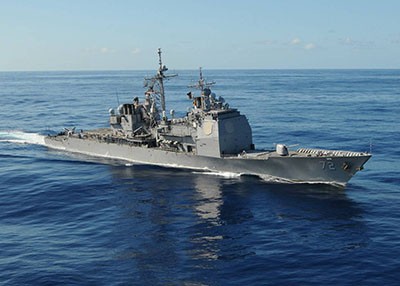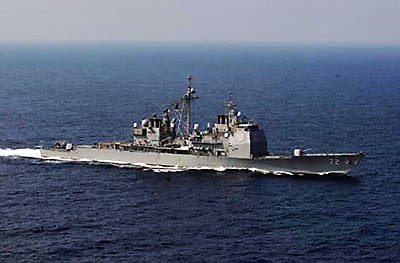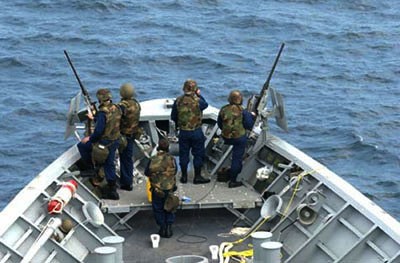Vella Gulf (CG 72)
Part 2: 1991-2001

(CG 72: displacement 9,650; length 567'; beam 55'; draft 33'; speed 30 knots; complement 376; armament Standard SM-2, Tomahawk, Harpoon, ASROC, Mk 46 torpedoes, 5-inch, Close In Weapon System, two SH-60B LAMPS Mk III helicopters; class Ticonderoga)
1991
The second Vella Gulf (CG 72) was laid down on 22 April 1991 at Pascagoula, Miss., by Litton Industries, Ingalls Shipbuilding Division; launched on 13 June 1992; sponsored by Mary A. McCauley, wife of Vice Adm. William F. McCauley (Ret.); and commissioned alongside Pier 12, Naval Operating Base (NOB) Norfolk, Va., on 18 September 1993, Capt. Constantine L. Xefteris in command.
Vella Gulf loaded her ammunition at Naval Weapons Station, Earle, N.J. (22–23 September), then visited New York City (23–26 September). The crew participated in a patriotic gala, “Salute to Freedom,” on board Intrepid (CVS 11) Sea, Air, and Space Museum (24 September). The NBC New York Weekend Morning show broadcast live from Vella Gulf (25 September), and then Fox New York’s “Good Day New York” broadcast the weather report from the cruiser (27 September). She returned to Norfolk on 28 September.
1992-1993
Vella Gulf then trained off the Virginia capes and southward toward Florida. Heavy seas caused her fuel tank bulkheads to pant, and the ship completed voyage repairs to the tanks at Litton Industries Ingalls Shipbuilding Division, Mayport, Fla. (24–26 October 1993). She steamed to Port Everglades, Fla., with Magnum 445, a Sikorsky SH-60B Seahawk of Helicopter Antisubmarine Squadron (Light—HSL) 44 Detachment 8 embarked. The cruiser carried out the in-port phase of her Weapons Systems Accuracy Trials at Port Everglades (28–31 October), followed by additional acoustic and torpedo trials on the ranges at the Atlantic Undersea Test and Evaluation Center (AUTEC) off Florida and the Bahamas (1–4 November). She then completed additional tests in Puerto Rican waters, including visits to Roosevelt Roads (7–8 November) and San Juan (23–27 November). Vella Gulf concluded her training by providing naval gunfire support to the Joint Special Operations Command at the range on Vieques Island, P. R. En route her return to Norfolk, the ship operated at the Wallops Island Flight Facility, Md. (5–6 December), and reached her home port on 7 December.
1994
She made for Puerto Rican waters for additional training (11–15 January 1994), and then sailed a counter-narcotics patrol with Joint Task Force (JTF) 4 in the Caribbean through the end of the month. The ship also visited Cartagena, Colombia (27 January), and Port Everglades (3–5 February), and returned to Norfolk on 10 February. Vella Gulf trained off the Virginia capes at times in February and March, and on 4 April sailed to Pascagoula. The ship completed work at the Ingalls yard (9–11 April), ran her final contract trials in the Gulf of Mexico (11–13 April), and underwent post shakedown availability (13 April–26 June). She returned to Norfolk on 1 July.
Vella Gulf accomplished deperming (11–13 July 1994), and sailed on 1 August to take part in the Maine Lobster Festival at Rockland (4–7 August), returning to Norfolk on 10 August. She made for the Caribbean for additional counter-narcotics patrols as part of JTF-4 (31 August–8 October). The ship embarked Magnum 456,a Seahawk of HSL-44 Detachment 6, embarking the first female LAMPS pilots on board the cruiser. During the ship’s operations in the Caribbean, she visited Guantánamo Bay, Cuba (3–4 September and 3 October) and Curaçao, Netherlands Antilles (30 September–2 October).
A severe storm swept into 83-foot merchant vessel Mescalero off the coast of Honduras on 22 September 1994. A waterspout tore off her mast and life raft and twisted the hull, separating some of the wooden planks. The boat began to take on water and Master Frank Collins issued a distress call. Collins reached Coast Guard Communications Station New Orleans, La., which contacted Coast Guard Group 7. The group dispatched a Lockheed HC-130 Hercules from Key Largo, Fla., which flew toward Mescalero’s last reported position. The group also queried JTF-4 concerning available ships or aircraft.
Vella Gulf had reached a position 119 miles from Mescalero when JTF-4 contacted the cruiser and ordered her to come about. Vella Gulf made for the stricken vessel at 25 knots, and launched Magnum 456, manned by Lieutenants Dana Gordon and Franklin, and Aviation Warfare Systems Operators 1st Class Robert Alexander and 2d Class Scott Palmer. “It was dark, raining, visibility was next to nothing making it almost impossible to spot the boat,” aircraft commander Gordon recalled. “We finally contacted them on radio and spotted a flare they fired, but the storm made it very difficult.” Mescalero foundered by the bow, and Palmer, the helo’s swimmer, dropped into the stormy water. Palmer swam to the boat, and one-by-one assisted the five crewmen to the hoist. The Seahawk hoisted the men aloft and returned them to the cruiser. Mescalero apparently sank shortly after the rescue, though no one saw the boat slip under because of the fierce weather. The five men recovered on board Vella Gulf, and Magnum 456 flew them to Grand Cayman two days later.
1995
The ship visited Port Canaveral, Fla. (1–2 January 1995), then sailed for a counter-narcotics patrol in the Caribbean, capping that duty with a port visit to Nassau, Bahamas (16–19 January) before she returned to Norfolk on 21 January. Vella Gulf accomplished maintenance and took part in a number of training exercises into the summer, including Operation Hornet’s Nest, a USMC air warfare exercise off Beaufort, S.C. (27–30 March), and Sharem antisubmarine training (27–30 April) and a Composite Training Unit Exercise (CompTuEx, 1–13 May), both in Puerto Rican waters. These exercises including support of the Lightweight Exo-Atmospheric Projectile program by acting as a primary tracking platform for a test of a kinetic kill vehicle.
Vella Gulf, with two Seahawks of HSL-44 embarked, then deployed to the Arabian Gulf in company with guided missile frigate Stark (FFG 31) on 13 June 1995. She accomplished repairs at Punta Delgada, Azores (21 June), reached the Sixth Fleet the following day, and stopped at Malaga, Spain (23–27 June), and Haifa, Israel (3–6 July). The ship passed through the Suez Canal (8 July), reached the Fifth Fleet the following day, and transited the Strait of Hormuz into the Arabian Gulf (15 July). Vella Gulf anchored at Bahrain (17–22 July), where Capt. Peter W. Marzluff relieved Capt. Xefteris as commanding officer on 21 July. The cruiser then patrolled the Arabian Gulf, stopping briefly at Dubai, United Arab Emirates (UAE), (2–6 August), before resuming her patrols.
Following Gulf War I, the coalition established Maritime Interception Operations (MIOs) to enforce UN Security Council Resolutions imposed against the Iraqis. The UN prohibited cargo originating from Iraq and imports not accompanied by UN authorization letters, though the food-for-oil agreement permitted the Iraqis to sell limited amounts of oil to pay for food and medicine. Vella Gulf primarily performed MIOs during her deployment, though also took part in Operation Southern Watch—the enforcement of the southern no fly zone over Iraq—and supporting Operation Vigilant Sentinel. At times, the ship controlled Grumman F-14A Tomcats of Fighter Squadron (VF) 213, and McDonnell Douglas F/A-18C Hornets of Strike Fighter squadrons (VFAs) 22 and 94, flying from aircraft carrier Abraham Lincoln (CVN 72).

The ship conducted ‘carrier shotgun’ operations with Abraham Lincoln (15–18 August 1995), then continued to patrol the Arabian Gulf, punctuating her routine by visiting Dubai (26 August–8 September), Bahrain (20–24 September), and Dubai again (6–12 October). Sister ship Vicksburg (CG 69) relieved Vella Gulf on 21 October. Vella Gulf’s Visit, Board, Search and Seizure (VBSS) team boarded and inspected a total of nine ships while performing MIOs during the deployment.
The guided missile cruiser came about, accomplished repairs at Jiddah, Saudi Arabia (28 October 1995), then passed through the Suez Canal (1 November). She operated with the Sixth Fleet in the Mediterranean, and carried out shallow water upgrades to the AN/SQS-53C sonar with the Spanish Navy while anchored at Alicante, Spain (5–7 November). The cruiser passed through the Strait of Gibraltar (8 November), visited Rota, Spain (8–10 November), embarked her Tigers (sons of crewmembers) at Bermuda (18 November), and returned with guided missile frigates Halyburton (FFG 40) and Stark to Norfolk on 21 November.
1996
The cruiser carried out maintenance and trained off the Virginia capes and southward to Florida through the summer. Capt. James W. Phillips relieved Capt. Marzluff as the commanding officer on 8 June 1996. Vella Gulf concluded a CompTuEx off Puerto Rico and Cherry Point, N.C. (8 August–19 September). The exercise included Standard SM-2 surface-to-air missile, RGM-84 Harpoon surface-to-surface missile, and Mk 46 torpedo firings, and visits to St. Croix, Virgin Islands (22–25 August), and Pensacola, Fla. (7–9 September). In addition, she test fired a BGM-109 Tomahawk Land Attack Missile (TLAM) (10 September). The ship completed a Joint Task Force Exercise (JTFEx, 11–23 October).
Vella Gulf deployed to the Mediterranean and Arabian Sea on 25 November 1996. She reached the Sixth Fleet on 9 December, and then made for the Adriatic to rendezvous with aircraft carrier Theodore Roosevelt (CVN 71) for NATO Operation Decisive Endeavor, part of Operation Joint Endeavour, the implementation of the Dayton Peace Accords within Bosnia and Herzegovina and Yugoslavia (12–22 December). Vella Gulf then operated as Adriatic Red Crown, independently of Theodore Roosevelt, while she worked with a USAF Boeing E-3 Sentry airborne early warning and control aircraft to monitor the skies over the Adriatic, and over Bosnia and Herzegovina, and Yugoslavia.
1997
Vella Gulf rounded off the year by visiting Valletta, Malta (23 December 1996–3 January 1997). The cruiser returned to the Adriatic for Decisive Endeavor (3–13 January), and then came about and visited Naples, Italy (13–16 January), Cannes, France (20–26 January), and Palma de Mallorca, Spain (28–31 January). Vella Gulf participated with attack submarine Atlanta (SSN 712) in Exercise Whale Watch in the Strait of Sicily (3–7 February), and then separately in Island Thunder in the Tyrrhenian Sea (10–14 February). During Island Thunder, the ship fired more than 200 5-inch rounds supporting amphibious landings on the Sardinian coast. Following the exercises, she put in to Naples (15–17 February), Genoa, Italy (18–20 February), and Rhodes, Greece (25 February–2 March).
Vella Gulf sailed with British, Greek, Italian, and Turkish ships during InvitEx, a NATO multi-warfare exercise in the Mediterranean (2–12 March 1997). The ship steamed toward the Suez Canal, stopping at Alexandria, Egypt (12–14 March), before she passed through the canal on 16 March. Vella Gulf escorted Theodore Roosevelt in the Red Sea and the Northern Arabian Gulf during Southern Watch. A second SH-60B Seahawk cross-decked from sister ship Leyte Gulf (CG 55) and embarked on board Vella Gulf while she operated with the Fifth Fleet. The cruiser also took part in an experimental theater ballistic missile defense tracking exercise. She visited Dubai (9–12 April), and then sailed from the Arabian Gulf. The ship passed through the Suez Canal on 20 April, and completed NATO exercises Eagle Arena with the Egyptian military and Poopdeck with Spanish forces in the Mediterranean (20–30 April). Vella Gulf visited Palma de Mallorca (1–9 May) before turning for home. Aircraft carrier John F. Kennedy (CV 67) relieved Theodore Roosevelt on 11 May, and Vella Gulf returned to Norfolk on 22 May.
Vella Gulf trained off the Virginia capes at times during September and October 1997. On 8 October, she sailed for New England waters and visited Newport, R.I. (10–15 October). The cruiser took part in the celebration of the 200th anniversary of the launching of the frigate Constitution (21 October 1797) at Boston, Mass. (17–21 October), before returning to Norfolk on 24 October. Additional training in the Atlantic and off the Virginia capes included a visit to Savannah, Ga. (1–3 November).

1998-1999
Capt. Brian G. Schires relieved Capt. Phillips as the commanding officer on 24 April 1998. The cruiser trained with allied ships in the Baltic (1 May–30 June). The ship spent 14 days at sea to accomplish the Total Ship Training Availability I and II, and to evade Hurricane Bonnie (mid–late August). She took part in a Second Fleet exercise that included a visit to St. John, Virgin Islands (November). Capt. Richard A. Feckler relieved Capt. Schires as the commanding officer on 16 December 1999.
2000–2001
The ship completed an overhaul at Marine Hydraulics International shipyard, Norfolk (1 January–30 June 2000). The cruiser also hosted the Spanish training ship El Juan Sabastian Elcano during Operation Sail 2000 (16 June). Vella Gulf accomplished a variety of training and upkeep requirements following her overhaul. In addition, the British Broadcasting Corporation visited the ship to support a Discovery Channel documentary on AEGIS-equipped warships (10 August). She visited New York City (5–10 November), and then participated in a series of missile and torpedo firing exercises off the Maryland coast (12–15 November). The training included the ship’s first firing of the Mk 53 Nulka Decoy Launching System.
Vella Gulf visited Tampa, Fla. (18–22 January 2001). The ship completed a drydock and ship availability at Metro-Marine, Portsmouth, Va. (14–28 February). She then worked-up with Theodore Roosevelt but discovered additional problems that necessitated a return to Metro-Marine (1–7 March). HSL-48 Detachment 5 embarked on board (3 March). Following her second period of yard work, Vella Gulf trained off the Virginia capes (8–20 March), that included operating as the air defense commander during dual aircraft carrier operations with George Washington (CVN 73) and Theodore Roosevelt (10 March).
The cruiser sailed for training off the east coast on 25 April 2001, and took part in Broward County Navy Days at Port Everglades (30 April–3 May). She completed a CompTuEx (1–30 June) and a series of exercises off the east coast and in the Caribbean during the summer, including a visit to Roosevelt Roads (2–4 August), and a Joint Task Force Exercise (JTFEx, 10–18 August).
Al-Qāidah terrorists attacked the U.S. on 11 September 2001. Within four hours of receiving notification of the attack, Vella Gulf emergency sortied into the eastern Atlantic. She then received orders to assume North Eastern Air Defense Commander (ADC). She established tactical data links and radar coverage and helped coordinate fighter combat air patrols over Boston, New York, and Washington, D.C., and developed command and control communications for the support and execution of homeland defense and air traffic control (11–14 September).
Vella Gulf loaded her final supplies of ammunition for deployment on 17 September 2001. Theodore Roosevelt sailed on 19 September, but Vella Gulf, with HSL-48 Detachment 5 embarked, sailed on Deployment 03-01 on 21 September, and made speed to rendezvous with the carrier. The ships passed through the Strait of Gibraltar overnight on 1 October. The cruiser visited Dukahyla, Egypt (9–11 October), and then participated in NATO exercise Bright Star 01/02 (12–23 October). The massive exercise involved more than 74,000 servicemembers from 44 countries. The scenarios included live-fire training, amphibious and desert operations, and force-on-force war games, and had been scheduled prior to the terrorist attacks. Vella Gulf visited Souda Bay, Crete (24–27 October).
The ship passed through the Suez Canal on 29 October 2001, through Bab el-Mandeb on 1 November, and the Strait of Hormuz (11 November). A flag that flew over the World Trade center in New York was flown out to Vella Gulf, and on 13 November the ship raised the colors. Journalists from WTKR News Channel 3 from Norfolk embarked overnight to report the event (13–14 November). Vella Gulf relieved guided missile cruiser Princeton (CG 59) as the TF 50 (alternate) ADC (15–19 November), and assumed the task force’s ADC for Operation Enduring Freedom on 23 November. In addition, the ship functioned as the Force Over-the Horizon Track Coordinator on 7 December. A Navy Morale, Welfare and Recreation Holiday show starring celebrity Jessica Simpson performed for the ship on 22 December, and journalists from ABC News “Nightline” embarked (28–30 December).


